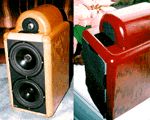Product Review - ENI
Revealer Loudspeakers; Mini-Monitor Speakers - January, 1996
By Jeanne Fairbrook
![]()
 |
ENI Revealer Loudspeakers; Mini-Monitor Speakers; One 6 1/2" low frequency driver, one 6 1/2" mid-range driver, one 1" dome tweeter; Size 19 1/4"H x 8 3/4"W x 12"D; Weight 50 pounds each; available in wood veneers of several colors; $1,200/pair (payable in advance, they won't cash your check for 30 days in case you don't like the speakers); E.N.I. Speakers, 6524 44th Street, Sacramento, California 95823; Phone 916-421-8935; Fax 916-739-6349.
ENI is a new company started by a couple of young fellows out of a small shop in Sacramento, California. Their first model release, the Revealer, is theoretically a mini-monitor by its size. However, it weighs as much as some larger speakers (50 pounds). The reason for this is the damping. Each speaker has two layers of 3/4" MDF on the sides, bottom, and top, with each layer separated by 1/8" of lead. The front has a 3/4" lead sheet backed up by a single layer of 3/4" MDF. The back is one sheet of 3/4" MDF. The inside walls have a layer of wool felt, then Deflex panels, bulk wool, and foam at the rear. That's a lot of damping. In fact, if you knock on the sides, it is almost entirely free of resonance. Both the tweeter enclosure and the two-driver enclosure are sealed (no ports).
The original sample was one of their first production runs, and they sounded very harsh even with our velvety SE triode. They did not sound that bad with the MOSFET and Bipolar output device amps, but something was just not quite right. We thought that this was going to be a real bomb. Then we got a call from Eugene at ENI, who asked if we were having any problems with the sound. When we explained that all was not well, he told us that the first few speakers had some glue that gave off volatile vapors which contaminated the ferro-fluid in the tweeter. So, we shipped them back and got the latest version in which this problem was corrected. The new ones also have non-removable grille cloths. Fortunately, we took a photo of the original speakers, which did not have any grilles at all, so we could illustrate the drivers (see photo). The tweeter is housed on top in a separate enclosure, with the mid-range and woofer below, in the main enclosure. The tweeter is by Vifa, and the other drivers are SEAS. The mid-range (the upper of the two 6 1/2" drivers) has the dust cap removed, so in this modest sense, it is customized. The tweeter has had the face plate removed, and the dome has been reattached to the magnet to reduce resonance . . . thus, a major modification of this driver. Some felt absorptive material is embedded in a recessed pocket immediately in front of the tweeter to minimize diffraction effects. The tweeter being placed behind the vertical plane of the other drivers represents a time-aligned configuration of the tweeter and drivers in the main enclosure (see photo). Crossover from the woofer to mid-range is first order at 125 Hz, and first order from mid-range to the tweeter at 1,750 Hz. This is a rather low crossover frequency to a tweeter, so the speaker is rated at 80 watts, in order not to overwhelm the high frequency driver.
Click HERE if your browser does not support tables.
Single Frequency Sine Waves
| Frequency: | 15 kHz | 10 kHz | 5 kHz | 1 kHz | 100 Hz | 50 Hz | 24 Hz |
| dB: | 92.1 | 91.4 | 84.5 | 80.0 | 90.1 | 83.2 | 79.1 |
Warble Tone Tests
| Frequency: | 1 kHz | 200 Hz | 160 Hz | 125 Hz | 100 Hz | 80 Hz | 63 Hz | 50 Hz | 40 Hz | 31.5 Hz | 25 Hz | 20 Hz |
| dB: | 80.0 | 74.4 | 76.8 | 75.8 | 79.6 | 79.1 | 71.8 | 71.7 | 68.0 | 66.6 | 67.4 | below scale |
The warble tone tests indicate a drop off in the 70 Hz area.
However, the single frequency sine wave tests show that the room
effects allow very low frequency stuff to come through, and that
is what we heard. Even at 24 Hz, the driver moved smoothly. When
listening to music, the bass was extended, tight, but just not
very loud.
The cabinetry is excellent, and high quality furniture finish. However, we would suggest that ENI either do a better job of attaching the grilles (see photo), or make them removable. These grilles are just fabric with no edging, and they detract from the overall looks. In fact, I would suggest getting them with no grilles, and making some yourself if you really want them.
In terms of the cabinetry, these speakers are delightful and worth far more than $1,200/pair. The sound could be a bit more detailed and less nasal for my tastes (the nasal tonality could probably be reduced by manipulating the placement and restricting the sweet spot, but I also feel speakers should sound good to more than one person in the room listening at the same time). However, ENI has made a good start in a very competitive market, and I would expect great things from this company in the years ahead.
Jeanne Fairbrook
Associate Editor
![]()
Manufacturer responds: The nasal quality and loss of detail you are experiencing are most likely due to off-axis listening in the vertical plane. It is critical that listening be done on mid-range axis, in order for the drivers to perform in a time and phase aligned fashion. Time aligned designs (especially with first order crossover) are very sensitive to vertical misalignment.
E.N.I.
![]()
© Copyright 1995, 1996, 1997
Secrets of Home Theater & High Fidelity
Return to Table of Contents for this Issue.

